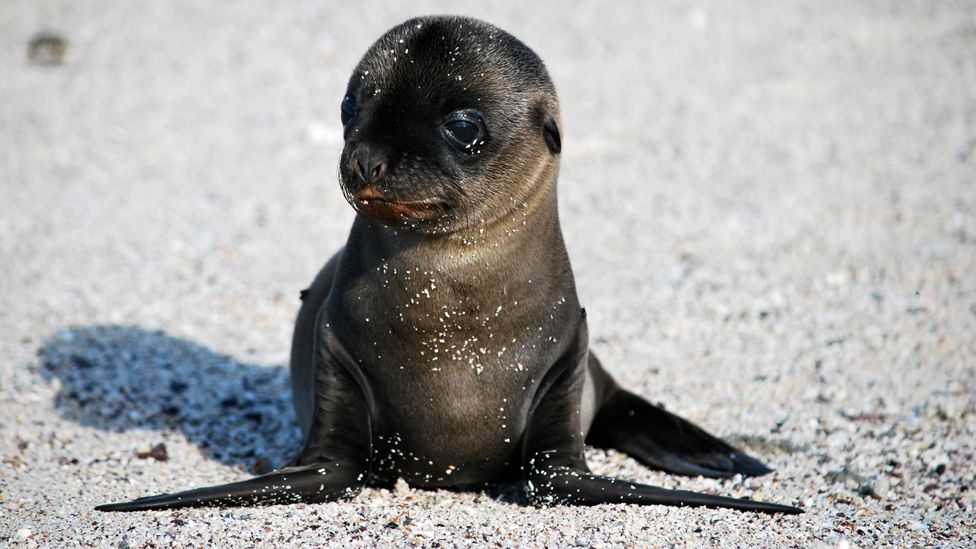Is the Pacific too warm for Galapagos sea lions?
- Published

Warmer sea temperatures around the Galapagos Islands could threaten the lives of baby sea lions - and the El Nino weather pattern, which has affected pups in the past, is to blame, writes Sally Kettle on a visit to Isla Espanola.
The Pacific Ocean laps just before me and a warm breeze reminds me I'm in the tropics. But this is no beach holiday and there's not a tourist in sight - just the raucous barking of a sea lion pup intent on making himself heard across the entirety of the otherwise peaceful island.
My loud companion is a Galapagos fur seal - they are found on most of the beaches and surrounding waters of the archipelago. They frolic above and below the waves and sleep languidly on hot rocks and warm sand.
With their whiskered faces, enormous eyes, portly appearance and short flat tails, these charismatic mammals warmly remind me of my dogs at home. They're incredibly playful too and I've already been lucky enough to spend a few afternoons snorkelling with them - they dart at full speed towards my face, missing by smidgens as they duck and dive around me.
On land it's common to find abandoned pups. Their outsize flippers render them ungainly as they clumsily flap at the water's edge. To people, their high-pitched cries seem distressing and it's tempting to scoop them up and comfort them, but touching any animal on the islands is strictly forbidden.
My naturalist guide, Andres Moreano, reassures me that this is completely normal. "Fur seal mothers leave their young for about two weeks at a time to fish in the deeper ocean and build up their fat reserves," he says. "The pups will be quite skinny by the time Mum comes back."
Fortunately for one such pup the wait has paid off. A plump female hauls herself on to the beach, helped by an incoming wave. She's also barking loudly but with a markedly lower note as she seeks her baby from the many pups abandoned here. It doesn't take long before mother and baby are reunited and normal suckling resumes. This well-rehearsed ritual is likely to be rudely interrupted, though.
Climatic events thousands of miles away have the power to transform this landscape. Some fear that by the end of the year there will be no pups barking by the shoreline. A phenomenon called the El Nino-Southern Oscillation has precipitated widespread changes in sea-level pressure across Indonesia, Australasia and the tropical Pacific. The effect can push warmer, nutrient-poor waters towards the Galapagos, and influence the weather as far away as Europe.
El Ninos occur every two to seven years, but the effect of the phenomenon is amplified by global climate change. In the Galapagos, a stronger El Nino generates significantly higher than average sea surface and air temperatures - these can be exacerbated by the arrival of the annual hot season around December.
The ocean warms up, leading to increased rainfall as the hotter air holds more evaporated moisture. In a particularly intense El Nino year, the islands can expect 15 times as much rain as in a regular season. This is great for terrestrial animal populations, such as the land iguanas and land birds, because plant growth explodes. But for sea life the effect is likely to be catastrophic.
With a shortage of essential nutrients, there is a sharp increase in marine mortality and breeding failure among creatures dependent on the ocean - marine iguanas, seabirds and of course the fur seals.
In 1998 the islands experienced one of the most powerful El Ninos on record. All of the fur seal pups died - their mothers were unable to find food close enough to the islands, meaning the little ones were left alone for longer than usual and died of starvation. The vast majority of the marine iguana population also perished as the algae they scavenge from the sea floor failed to grow in the warmer waters.
But the species hardest hit was the diminutive Galapagos penguin. Even now, its numbers are yet to return to pre-1998 levels. So naturalists are concerned about the viability of the species during this current El Nino, and fear they could be pushed to extinction.
For now I sit with the seal pups on an island that has extraordinary changes to come. But this volcanic archipelago, shaped by lava and the sea, has weathered plenty of change in its time. It's in its nature.
How to listen to From Our Own Correspondent:
BBC Radio 4: Thursdays at 11:00 GMT and Saturdays at 11:30 GMT
BBC World Service: At weekends - see World Service programme schedule or listen online.
Subscribe to the BBC News Magazine's email newsletter to get articles sent to your inbox.